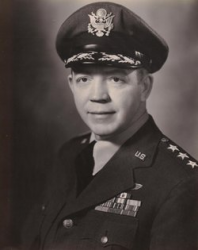
 |
|
|
||
|
Howard Arnold Craig 'Pinky' |
||||
|
Engagements: • World War II (1941 - 1945) |
||||
| Biography: | ||||
|
Howard Arnold "Pinky" Craig Howard Arnold Craig was born on 22 December 1898 in Philadelphia, PA. In 1909 at age 10, he saw his first aircraft on the beach at Atlantic City. The pilot, who actually offered him a free ride, was the noted pioneer aviator, Walter Brookins. Craig was infected by the aviation bug that summer and he never recovered. Military Career Craig enlisted in the Signal Corps' Aviation Section in November 1917. He then attended the school of Military Aeronautics at Princeton University and served at Camp Dick, TX; Selfridge Field, MI; and Hazelhurst Field, NY. In June 1918, he was commissioned a Second Lieutenant in the Aviation Section and, two years later, was appointed a First Lieutenant in the Regular Army's Air Service. Known as 'Pinky' throughout his military career, Craig served in various field, staff and school assignments for the next 13 years. During the interwar years, he was a bomber pilot and participated in General Mitchell's bombing of the battleships USS Virginia and USS New Jersey in September 1923. He attended the Air Corps Tactical School at Maxwell Field, AL, in 1932, and he was promoted to Captain in October 1933. Craig was a student at the Command and General Staff School at Fort Leavenworth, KS, during 1935-36; he graduated in June of '36 and was promoted to Major in August. From 1936-38, Craig served at Langley Field, VA, where he was assigned as Personnel Officer, 2d Wing, General Headquarters Air Force. From 1938-40, he was Commanding Officer of the 21st Reconnaissance Squadron, also at Langley. Craig went to Washington, DC, in May 1940 as Assistant to the Chief of the Plans Division, Office of the Chief of the Air Corps, where he helped plan the North African invasion. He was promoted to Lieutenant Colonel in March 1941. He was advanced to Colonel in January 1942 and became Assistant Chief of the Air Staff for Plans, Headquarters U.S. Army Air Forces, a month later. Craig went to England in June 1942 and became Assistant Chief of Staff for Operations, European Theater of Operations, U.S. Army (ETOUSA). That August, he got his first star as a Brigadier General. Two months later, he was named Deputy Chief of Staff for Air, Allied Forces Headquarters, in England and North Africa. His next assignment was as Commanding General of the XII Air Support Command, a fighter group, in Algeria. Craig was one of the few Allied officers familiar with Western Desert practice. He had accompanied British Air Chief Marshal, Sir Arthur Tedder, on his return to the Middle East in December and had spent a good deal of time with British Field Marshal Bernard Montgomery in Tripolitania discussing the current thinking on Army-Air operations. In February 1943, Craig became Chief of Staff of the Mediterranean Air Command. In August 1943, Craig returned to the U.S. as Assistant Chief of the Air Staff for Operations, Commitments and Requirements, Headquarters U.S. Army Air Forces, Washington. He was promoted to Major General the following February. He was assigned to Chief of the Theater Group, Operations Division, War Department General Staff, Washington, in October 1944. Craig became Commanding General of the Alaskan Department in June 1946. A highly significant organizational change occurred on 1 January 1947; the Alaskan Command (ALCOM) was established as one of the first of three unified commands to be created to provide unity of command. Its establishment resulted partly from the lessons learned during WWII. Craig, a newly promoted Lieutenant General, was made the first Commander-in-Chief, Alaskan Command (ALCOM). ALCOM's mission was to provide for the defense of Alaska and protect the North American continent from attacks coming across the polar region. Another, more visible, mission was humanitarian support. Time and again, the military came to the aid of its civilian neighbors during times of need that ranged from the 1964 Good Friday earthquake to routine search and rescue missions. With the establishment of the U.S. Air Force as a separate service on 18 September l947, senior military leadership in Alaska passed to the Air Force, where it has remained ever since. Craig was replaced by Lt. Gen. Nathan F. Twining in October l947. From November 1947 to August 1949, Pinky served as Deputy Chief of Staff for Material, in the newly created Headquarters U.S. Air Force, in Washington. In September 1949, he was appointed Inspector General of the Air Force. Craig insisted that inspection should not be a career field because officers often lost contact with the field and its problems after prolonged inspection duty. For that reason, Craig established a rotation policy with maximum tours of three years of inspection duty for officers. Craig became Commandant of the National War College in July 1952; he took on additional duty as Chairman of the Inter-American Defense Board, the following February. He retired from active duty on 30 June 1955. Conclusion Howard Arnold Craig entered the service during World War I, stuck with it through the lean years of the next two decades, rose to high rank during World War II, and then helped shape the new era and the new Air Force that followed. Although he wasn't one of our country's most famous airmen, Pinky Craig was a reliable, highly-capable professional who served his country well. Death and Burial Lieutenant General Howard Arnold Craig died on 14 September 1977. He is buried at Fort Bliss National Cemetery in El Paso, TX. |
||||
| Honoree ID: 3270 | Created by: MHOH | |||
Ribbons
Medals
Badges
Honoree Photos
 |  |  |
 |  |
 |


